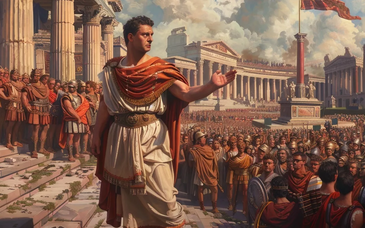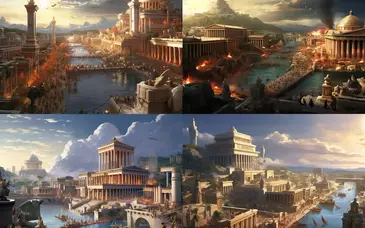The Second Samnite War lasted twenty years and was not a defensive venture for Rome. At first the Roman arms were so successful that in 321 BC the Samnites sued for peace. But the terms offered were so stringent that they were rejected and the war went on. In the same year the two consuls, leading an invading force into Samnium, were trapped in a maountain pass known as the Caudine Faroks wehre they could neither advance nor retire, and after a desperate struggle would have been annihilated if they had not submitted to the humiliating terms imposed by the Samnite victor Pontius. The troops were disarmed and compelled to pass 'under the yoke', man by man, as a fow vanquished and disgraced. This ancient ritual was a form of subjugation by which the defeated had to bow and pass under a yoke used for oxen. (In this case it was a yoke made from Roman spears, as it was understood to be the greatest indignity to the Roman soldier to lose his spear.)
Six hundred knights had to be handed over as hostages.
Meanwhile the captive consuls pledged themselves to a treaty on the most favourable terms for the Samnites.
Caudine Forks
But the Roman senate refused to ratify the terms, and again the war went on.
For six years, till 314 BC, success seemed to flow with the Samnites. Campania was on the verge of deserting Rome. Then the tide turned. But the Roman victory was delayed by the intervention of the Etruscans in 311 BC when the forty years peace reached its end. It was only postponed, however. After the first shock the Romans continuously defeated both their enemies. In 308 BC the Etruscans sued for peace which was granted on severe terms and in 304 BC the Samnites obtained peace on terms probably severe but not crushing.
Fir in 298 BC the Samnites renewed the war. Enemies were stirred up against Rome - Etruscans, Gauls, Umbrians, Sabines - on every side. But they lacked unity, and a shattering victory was won over their combined forces at Sentinum in Umbria in 295 BC.
Nevertheless, the stubborn Samnites fought on till a final defeat in 291 BC made further resistance hopeless, and in the following year peace was made on more favourable terms for the Samnites than Rome would have granted any less dogged foe.
The Campanian cities, Italian or Greek, through which Rome had been involved in the Samnite wars, Capua and others, were now allies of Rome, with varying degrees of independence. Roman military colonies were settled in Campania as well as on the eastern outskirts of Samnium.



